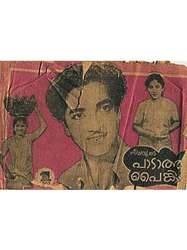Chechi is a film of genre Drama with Kottarakkara Sreedharan Nair
Chechi (1950)

If you like this film, let us know!
Genres Drama
Chechi is a 1950 Indian Malayalam film, directed by T Janaki Ram and produced by Swami Narayanan. The film stars Kottarakkara Sreedharan Nair and Miss Kumari in lead roles. It is the debut film of music director G. K. Venkatesh, playback singer T. A. Lakshmi and director T. Janakiram. It is remembered for the classical-based song "Kalitha kalamaya Kailasavasa".
^ "Chechi (1950) Movie Details". Spicy Onion. Retrieved 2014-09-23.
^ "Chechi (1950)". Malayalam Movie Music Database. Retrieved 2014-09-23.
^ Vijayakumar, B. (2011-02-11). "Chechi 1950". The Hindu.
Actors
Comments
Leave comment :
Suggestions of similar film to Chechi
There are 84 films with the same actors, 61703 with the same cinematographic genres, to have finally 70 suggestions of similar films.If you liked Chechi, you will probably like those similar films :

Sasidharan (1950)
Genres Drama, Musical
Actors Nagavally R. Sreedhara Kurup, Kottarakkara Sreedharan Nair, Miss Kumari, S. P. Pillai, T. R. Omana, Aranmula Ponnamma

Padatha Painkili (1957)
Genres Drama, Romance
Actors Prem Nazir, Miss Kumari, Kottarakkara Sreedharan Nair, K. V. Shanthi, Bahadoor, Aranmula Ponnamma
Vendor Kutty (Kottarakkara Sreedharan Nair), a wealthy villager, is jealous and scheming to marry his daughter Lucy (Shanthi) to the richest bachelor of the town. He is, however jealous of Luke (T. S. Muthiah), the neighbour, who is kind-hearted village school teacher and has a daughter Chinnamma (Miss Kumari), of marriageable age.

Bhakta Kuchela (1961)
, 2h50Genres Drama, Fantasy
Actors Thikkurissy Sukumaran Nair, Kottarakkara Sreedharan Nair, Miss Kumari, Tadepalli Lakshmi Kanta Rao, Aranmula Ponnamma, Ambika Sukumaran
It tells about sage Sandipani’s hermitage where Krishna and Kuchela are students and close friends. The difference in social status, caste or creed does not come in the way of their friendship. After leaving the hermitage they lose contact with each other. Krishna becomes the king of Dwaraka, while Kuchela struggles to make ends meet with a huge family. His worship of Krishna causes enmity with the king Sisupala. As requested by his wife Suseela, Kuchela decides to visit his old friend. For him it was a chance to renew their friendship than asking for assistance. Kuchela gets a warm welcome at Dwaraka but forgets to ask what he actually wanted. To his astonishment Krishna sends him back empty handed. But when Kuchela returns home he finds that his modest hut has miraculously been turned into a palace. The Lord had showered prosperity on his family even without asking for it.

Achanum Bappayum (1972)
Directed by K. S. Sethumadhavan
Genres Drama
Actors K. P. Ummer, Jayabharathi, Kottarakkara Sreedharan Nair, Adoor Bhasi, Bahadoor, Philomina
The film tells the story of a Hindu man who adopts a Muslim child and allows her to follow Muslim traditions.

Nellu (1974)
Directed by Ramu Kariat
Genres Drama, Romance
Actors Prem Nazir, Jayabharathi, Thikkurissy Sukumaran Nair, Sankaradi, Kottarakkara Sreedharan Nair, Adoor Bhasi
Rating64%





The film portrays the life of "Adiyar" community, a tribe whose ways of life belongs to centuries ago. They live in the Wayanad hills in the deep Kerala forests. The film envelopes the passions, superstitions, religious practices, customs, and the servility and exploitation the tribal people endure. The film is narrated through the observations of an outsider.

Prayanam (1975)
Directed by Bharathan
Genres Drama
Actors Mohan, Kottarakkara Sreedharan Nair, Mohan Sharma, Lakshmi Narayan, Kaviyoor Ponnnamma, Veeran
Rating73%






Kumara Sambhavam (1969)
Genres Drama, Historical, Musical
Actors Gemini Ganesan, Kottarakkara Sreedharan Nair, Thikkurissy Sukumaran Nair, Sharada, Padmini Ramachandran, Sreevidya
Rating63%






Aranazhika Neram (1970)
Directed by K. S. Sethumadhavan
Genres Drama
Actors Kottarakkara Sreedharan Nair, Prem Nazir, Sathyan, K. P. Ummer, Adoor Bhasi, Ragini
Rating74%






Prasanna (1950)
Genres Drama, Romance
Actors Pappukutty Bhagavathar, Kottarakkara Sreedharan Nair, Lalitha, S. Balaiah, P. A. Thomas, Ragini
 Connection
Connection



